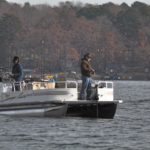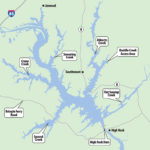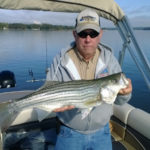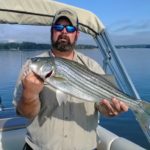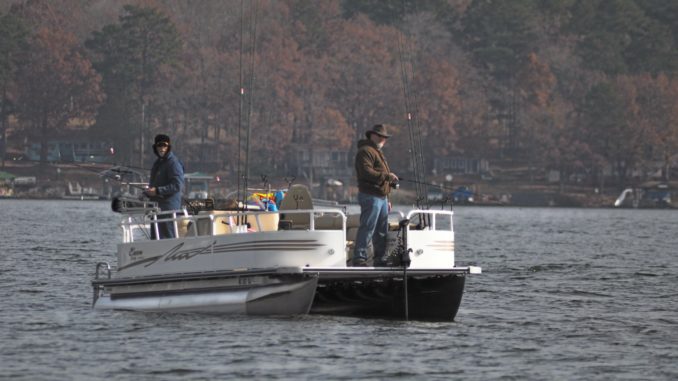
Savvy fishermen allow birds to lead them to the baitfish that lead them to High Rock’s striped bass
The winter months, particularly December through February, are best times to pursue striped bass in large impoundments across North Carolina, and High Rock Lake on the Yadkin River south of Lexington has consistently been a top producer.
One fisherman who regularly takes advantage of the opportunities High Rock presents is Maynard Edwards of Lexington’s Yadkin Lakes Guide Service.
“Good striper fishing usually begins at High Rock in December, but it may crank up in late November if it’s cold enough,” said Edwards, who concentrates on the area between the mouth of Crane Creek downstream to High Rock Dam as winter approaches. “I look for circling and diving gulls or birds sitting on the water.
“It’s not a bad idea to go where birds are sitting on the water. I’d definitely go to such a place if I couldn’t find any flying. In either case, they’re looking for baits.”
Once he settles on an area that looks promising, Edwards uses a technique he calls “strolling” — slow-trolling baits and lures.
“I’d rather have live bait that time of year,” he said. “Once I get in an area with baitfish, I want to put my baits under baitfish schools on the surface.”
When he “strolls” for striped bass, Edwards wants to cover a wide swath of water. His terminal tackle includes Waterbugz planer boards and rigs built with a 1/8-ounce weight in front of a swivel, three feet of leader and a 3/0 to 4/0 circle hook. He’ll put out two or three rods with planer boards.
“I’ll put out 30 feet of line then add a planer board to send it out (to the side),” Edwards said. “The weight is just enough to keep the bait under the surface. The (baitfish) will find his own depth with (the boat) only moving at 8/10 mph.
“I also put out two float (surface) rods out the back with ready-release floats, then I’ll use some down lines,” he said.
“I like this arrangement because if you want to stop you can. You can’t do that with artificial lures (that sink to the bottom).”
Edwards’ float rods use the same terminal tackle — except for 2- to 3-ounce lead weights.
“I set one to run eight feet deep and one to run 12 feet deep,” he said.
Edwards puts floats on the line with slip knots so he’s always sure the depths his lures are running.
“I’ll let one out 50 feet behind the boat and another 75 to 100 feet back,” he said.
He’ll also places a down rod at each corner of his boat.
“I run (baits) at four depths,” he said. “The front rods will have eight to 10 feet of line out while the back (baits) will be 16 to 20 feet behind the boat.”
He uses line-counter reels so he can set his line lengths correctly.
“They’re easy to adjust,” Edwards said. “I run about 10 rods, but I have put out as many as 12 rods if I’ve got three clients aboard. They keep up with the rods.”
If live bait isn’t available, he’ll pull artificials.
“I know a lot of people pull a 3- or 4-inch artificial shad with a paddletail, but if I’m using artificials, I like Zoom Swimming Flukes — the big ones, 5-inches long. They’re slender, and I think they look halfway like a herring.”
Edwards said sometimes he switches tactics for variety.
“I still troll bucktails, but lemme tell you, I also like Alabama rigs,” he said. “If I’m pulling artificials, you can bet there are two Alabama rigs in the mix.”
Edwards, who makes his own 5-arm Alabama rigs, goes at it a little differently than most anglers, opting for light weights.
“I’d been pulling umbrella rigs for years, so when Alabama rigs came out two years ago, I said, ‘Shoot, that’s just a small umbrella rig,’ ” he said.
And Edwards went about making his own.
“I’ll put a half-ounce unpainted head on the rig then use 1/4-ounce jigheads with 3/0 stainless ocean-style Eagle Claw hooks,” he said.
Along with 5-inch Zoom Super Flukes and 4-inch Super Fluke Juniors, he’ll occasionally use yellow or white Zoom or Z-Man paddletails.
“If it’s a normal temperature I’ll use a 5-inch Fluke,” he said. “If it’s really cold, I downsize to a 4-inch Fluke Junior.”
His trolling rods are spooled with 40-pound braided line connected to the Alabama rigs by way of a 140-pound dual-lock Super Snap that’s mated to the braid with an improved clinch knot.
“I also have some 1/8-ounce lures I use for casting,” he said. “I’ll cast from January through March. You never know if you’ll catch a largemouth or striper. Sometimes I cast bucktails.”
By the end of December, Edwards will spend most of his time in Flat Swamp, Abbotts and Crane creeks.
“The best are Flat Swamp and Abbotts,” he said. “I don’t go into Crane Creek unless it gets really cold.”
Edwards laughs when he hears anglers complain that Yadkin Inc., a division of Alcoa that operates hydroelectric plants on several Yadkin system reservoirs, drops High Rock’s level in winter.
“The winter drawdown used to be 15 feet, but the last three or four years they haven’t dropped it major,” he said. “Some people fuss and cuss, but, hey, it’s like this — when the lake goes down, the stripers have fewer places to hide. The less water you have to cover, the better chance you have to catch fish. If the water is up, (stripers) will go into the creeks and stay there because that’s where the baitfish will be.”
Because stripers prefer 55-degree water, winter is the top time to pursue them at High Rock Lake. They usually don’t grow to trophy sizes, but even medium-size fish can put a significant bend in a rod.
“High Rock stripers probably average seven to 10 pounds,” Edwards said. “Anything 10 pounds or better is a real good striper. Twenty-pounders aren’t unheard of but aren’t a normal thing.”
DESTINATION INFORMATION
HOW TO GET THERE/WHEN TO GO — High Rock Lake is south of Lexington, with ramps off NC 8 at Abbotts and Flat Swamp creeks on the west side of the lake and at Second Creek off Bringles Ferry Road on the west side. The best fishing is December through February.
TECHNIQUES/TACKLE — Slow-trolling live baits with gizzard shad or artificial lures such as Alabama rigs, bucktails, Striper Swiper jigs, Zoom Swimming Flukes or Z-Man paddletail lures. Tackle includes 61/2- to 7-foot, medium-action rods and reels spooled with 40-pound braid. Keep speed at .5 mph for best results.
GUIDES/FISHING INFO — Maynard Edwards, Yadkin Lakes Guide Service, 336-249-6782, www.ExtremeFishingConcepts.com. Also, see Guides and Charters in Classifieds.
ACCOMMODATIONS — Quality Inn, NC 8 at I-85, Lexington, 336- 243-2929; HWY 8 Motel, NC 8 at I-85, Lexington, 336-357-6444; Country Hearth Inn, NC 8 at I-85, Lexington, 336-357-2100; Super 8, I-85 at US 52, Salisbury, 704-738-8888; EconoLodge, I-85 at US 601, Salisbury, 704-431-4542;
MAPS — DeLorme’s N.C. Atlas & Gazetteer, 800-452-5931, www.delorme.com.

